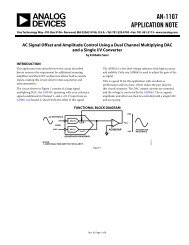Sailesh Chittipeddi - EEWeb
Sailesh Chittipeddi - EEWeb
Sailesh Chittipeddi - EEWeb
You also want an ePaper? Increase the reach of your titles
YUMPU automatically turns print PDFs into web optimized ePapers that Google loves.
M1 OFF when M2 is conducting current. The disabled<br />
FET does not contribute to the resultant output voltage<br />
in either case.<br />
For both types of uni-directional or bi-directional CSAs,<br />
gain error accuracy is a measure of how well-controlled<br />
is the ratio of ROUT to RGAIN, especially over<br />
temperature. Gain error accuracy can be <br />
100μV or more.<br />
The CSA’s SIGN Output Comparator<br />
The bi-directional CSA incorporated one additional<br />
feature as was shown in Figure 2 – an analog comparator<br />
the inputs of which monitor the internal amplifier’s<br />
differential output voltage. The SIGN comparator<br />
output indicates the load current’s direction while the<br />
voltage at its OUT terminal indicates the magnitude of<br />
the load current. The SIGN output is a logic high when<br />
M1 is conducting current (VRS+ > VRS). Alternatively,<br />
the SIGN output is a logic low when M2 is conducting<br />
current (VRS+ < VRS-).<br />
Note that the SIGN comparator exhibits no “dead zone”<br />
at ILOAD switchover, unlike other bi-directional CSAs<br />
where hysteresis was purposely introduced to prevent<br />
comparator output voltage chatter. The load current<br />
transition band is less than ±0.2mA with respect to a<br />
50-mΩ external sense resistor. Other types of CSAs<br />
OUT<br />
VDD<br />
LOAD<br />
SIGN<br />
0.1µF<br />
0.047µF<br />
To AC Wall Cube<br />
OR Charger<br />
+3.3V<br />
Figure 2: A Typical Application for a Bi-directional High-precision Current Sense Amplifier<br />
(Touchstone Semiconductor’s TS1101).<br />
V DD<br />
Microcontroller<br />
ADC Input<br />
Digital Input<br />
Visit www.eeweb.com<br />
29















